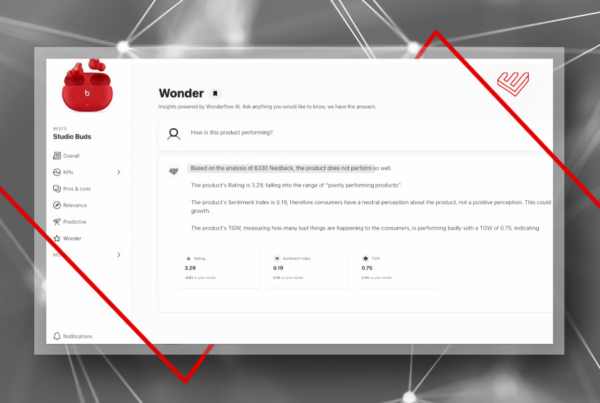Text mining sounds like a fancy term, but the concept behind it is pretty simple. In a nutshell, this involves using machine learning technology to extract valuable information from text-based data (product reviews, emails, call center data, and more). The strategy of text mining is used widely by consumer insight teams, and it can help product marketers and researchers understand their customers’ pain points, how customers use certain products, and more.
Want to learn more about text mining, and explore the possibilities of using text mining for your company? In this blog post, we’ll walk you through:
- Text mining techniques
- The power of text mining for consumer insight teams, and
- The different departments that benefit from text mining
Read on to find out more!

Text Mining Techniques: A Quick Introduction
As we’ve mentioned, text mining deals with using technology to extract information from text-based data. The most obvious source of data is, perhaps, product reviews that you find on websites such as Amazon — but that aside, other data that can be analyzed include:
- Point of sale data
- Social data
- Call center data
- Data from loyalty programs
- Data from apps
- Surveys
- Email feedback
- Focus group data
Text mining relies on a three-part process to extract information, with the three parts being entity extraction, categorization, and sentiment analysis.
Part One: Entity Extraction
The first step is to identify the text to be mined. If you’re mining a database, your tech team will have to identify the specific field containing the text. If the text data is housed in multiple files, you’ll have to assemble the files in a single location.

From here, you’ll mine the text to extract structured data and apply machine learning algorithms to the source text.
Part Two: Categorization
Before you go ahead and analyze your data, you’ll have to come up with concept and category models that can help you make sense of your data.
Typically, consumer insight teams find that the data they have on their hands are linked to thousands of concepts, many of which are far beyond your scope or jurisdiction. If that’s the case, one strategy is to hone in on the most popular or frequently mentioned concepts and disregard the other concepts which only surface in one or two instances throughout all your data.
Part Three: Sentiment Analysis
Here’s the toughest part — analyzing your data. Here, consumer insight teams use data mining techniques to discover relationships between the concepts previously identified.
The specific techniques used include clustering, classification and predictive modeling. Companies might either stop here, or go one step further in merging their extracted concepts with other sets of data to predict future behavior.
The Power Of Text Mining Techniques for Consumer Insights Teams
Consumer insight teams can use text mining to achieve a number of business objectives, including learning about their customers’ pain points, understanding whether their product/service lives up to their customers’ expectations and more.
Pain points and Unique Selling Proposition
First up, consumer insight teams may use text mining to understand their customers’ pain points and to understand why customers choose to use their product/service. (In business speak, the latter is known as a company’s Unique Selling Proposition or their USP).

For instance, a company that sells vacuum insulated lunch boxes, for example, might know that their product caters to several categories of consumers — including those who would like to eat healthier, those who are trying to save money and more.
Now, say the company analyzes their data and finds out that the vast majority of their customers are dealing with a weight loss issue. Now that the company knows that their consumers are choosing to pack their lunches so that they can have better control over the food they eat, they can use this information to fine-tune their messaging and pitch accordingly.
Website copy and messaging aside, if the company is looking into expanding their content marketing strategy, they might also create more marketing collaterals (blog posts, ebooks, pamphlets, etc) that teach consumers how to prepare healthy meals and utilize their lunch boxes to maintain a healthy lifestyle.
Consumer insight teams aside, other stakeholders in your company should benefit from consumer feedback analysis. Check out this video to learn more.
Expectations vs reality
Next, text mining is also valuable for companies who are trying to look into whether their product/service lives up to consumers’ expectations.

It’s fairly simple to pick out positive or negative sentiment here — if your product reviews contain a lot of positive language such as “fantastic”, “great”, “useful”, then you’ll know you’re on the right track. If your product reviews contain negative phrases, on the other hand, then it’s worth taking a closer look at why your customers are unsatisfied and improving upon your product accordingly.
Benchmark your performance against the competition
Moving on, text mining can also help you benchmark your performance against your competitors’.

In product reviews, consumers tend to compare the product at hand with similar products they’ve used. Here, they might point out how your product is advantageous in certain ways, but doesn’t perform well in other ways.
With this information, consumer insight teams get a better idea of how their brand stacks up against the other brands in the market and decide if they need to respond by improving their product. If the brand that the team is managing is priced at a premium and the company justifies this price by asserting that their product is the most effective one in the market, then they’ll definitely want to look at tweaking the product to live up to those claims.
Understand what customers like/dislike about your product
Running in the same vein, text mining also allows you to uncover what your consumers like and dislike about your product.

You’ll likely find some conflicting information here — Consumer A might state that they like Feature A, but Consumer B might assert that Feature A is useless and doesn’t do much for them. Bearing this in mind, look at what the data says as a whole instead of getting swayed by outliers and anomalies.
If you have more data (eg data on your customers’ Lifetime Value) on hand, think about analyzing your text in conjunction with this additional data. You might find that:
- The majority of consumers who don’t like Feature A tend to have a low lifetime value and won’t stick around long, and that;
- Your customers who make repeated purchases have no issue with Feature A.
If that’s the case, there’s obviously no need to tweak your product to satisfy your once-off customers.
Understand how customers use your product
Next, you can also discover surprising insights about how your customers use your product via text mining and text analysis.
For example, if you sell a travel kettle and you find that several of your customers are talking about how they used their kettle to cook pasta while they were on the road, then you’ve just discovered a whole new use case for your product. Depending on your overall strategy, you might decide to play up this use case and showcase it as an additional product feature.
Learn more about how Wonderflow is helping global brands to become customer-centric using an AI-based technology.
Narrow in on safety issues and other concerns
Last but not least, consumer insight teams can also rely on text mining to flag out safety issues and other concerns that are important for the company to take note of.
For instance, if teams conduct a text analysis and find that many customers are talking about how their product was dangerous to use or malfunctioned in some way, then it’d be a wise move for the company to do some investigating and find out if there were problems that arose in manufacturing.
If that’s the case, the company might then do a product recall and compensate their customers. This might not be an ideal situation, but it’s preferable to dealing with scathing, reputation-tarnishing reviews on social media, or worse, having a customer take you to court.
Who Else Will Benefit From Consumer Feedback Analysis In Your Company
Consumer insight teams aside, other stakeholders in your company who will benefit from consumer feedback analysis include: product marketers, research and quality control teams, customer service teams and business / market intelligence teams.
Product marketers
With access to consumer insights, product marketers can get to know their customers like the back of their hands. To be more specific, these insights allow marketers to dive deep and identify the “make-or-break” factors that influence a customer’s purchase decision.

From here, product marketers can choose to highlight certain features that are important to their customers when running ads or marketing campaigns. At the same time, these marketers can also improve upon their pitch and fine-tune their messaging to resonate with their customers.
Research and quality control teams
Research and quality control teams are responsible for product improvements. With consumer insights, these teams are better-equipped to make strategic decisions about whether to improve a product, pull the plug on it or continue manufacturing it as it is.

Now, the general consensus is that all products are a work-in-progress and it’s always possible to improve on any given product. That said, the question here is whether a product change (that will cost a company in terms of both time and money) is worth it and how this change will impact sales, revenue, and overall customer satisfaction.
Customer service teams
Moving on, text mining and natural language processing techniques are also widely used for customer care applications. Here, companies may use text analytics software to unlock insights from surveys replies, trouble tickets, customer call notes and more.

With these insights, the companies are then able to optimize their customer service quality, and work towards resolving problems more quickly. Text analysis is also used to build chatbots and implement automated customer responses, which helps to reduce dependency on call center operations.
Whichever way you look at it, using text mining in the area of customer service results in a win-win. Customers get their problems resolved more quickly (if chatbots are implemented, they may even get to enjoy instant replies); businesses, on the other hand, are able to do more with less, leading to cost reductions.
Business / market intelligence teams
Finally, text mining also comes in handy for business and market intelligence teams. These teams make use of the data and insights they extract to get a better understanding of the business landscape and identify their strengths and weaknesses.

All in all, market intelligence teams who rely on text mining are more well-equipped to devise innovative strategies that will help them maintain a strong foothold in the market.
If your goal is just to maximize your profits in the short run, then you might be able to do away with using text mining to provide insights to your market intelligence teams. But if you’re in this for the long haul and you want to build a legacy with your company, then it’s crucial to invest in market intelligence to make sure that you’ve got a high-level perspective of the business landscape.




